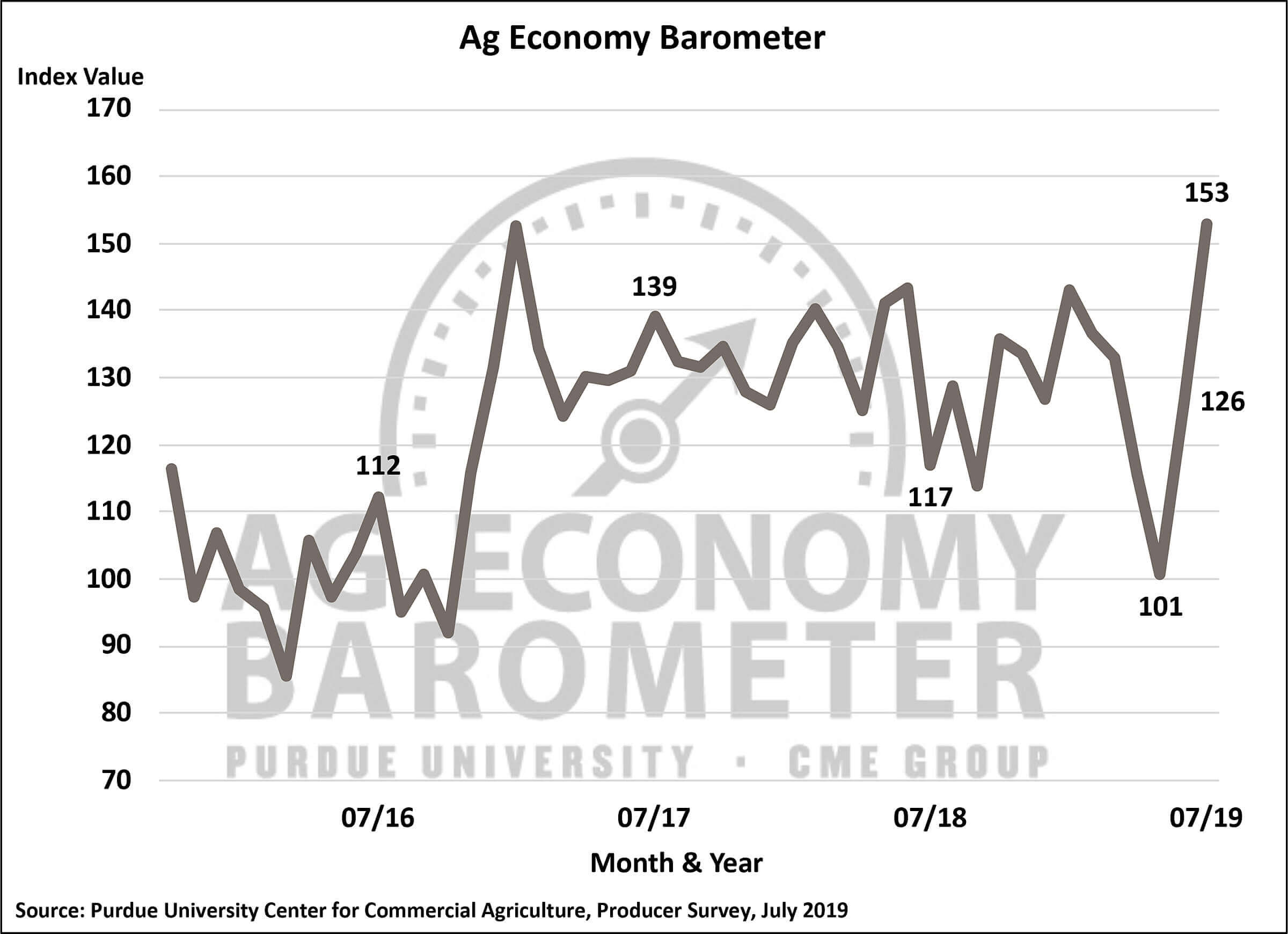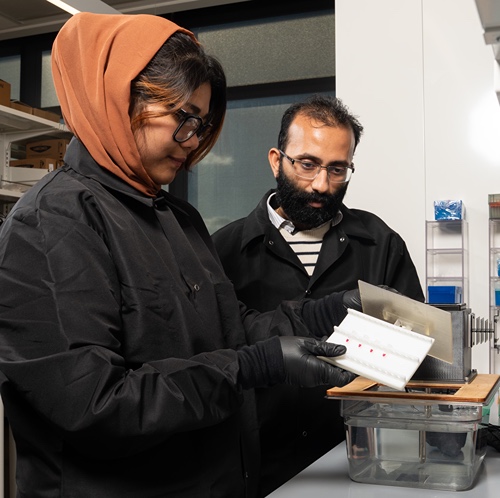Confidence in the ag economy soars; producers confirm large prevented plantings of corn and soybeans
The Purdue University/CME Group Ag Economy Barometer reading jumped to 153 in July, up 27 points from June, and up 52 points from May. Improving crop conditions after an extraordinarily wet planting season, combined with a late spring/early summer crop price rally, boosted farmer sentiment. This improvement occurred despite the fact that many producers were in the midst of filing prevented planting crop insurance claims and wondering about the size of the USDA’s 2019 Market Facilitation Payments (MFP). Results are based on a survey of 400 agricultural producers across the U.S. conducted from July 15 through July 19, 2019, which was prior to USDA’s announcement of 2019 MFP payment rates.
A big driver of sentiment was producers’ improved expectations for current economic conditions. The Index of Current Conditions, a sub-index of the ag barometer, increased 44 points in July to a reading of 141, marking the largest one month improvement since data collection began in October of 2015. The barometer’s other sub-index, the Index of Future Expectations, also increased, up 18 points from June, to a reading of 159 in July.
“The Corn Belt is continuing to see better crop conditions and that has farmers, at least momentarily, breathing a sigh of relief. However, the agricultural economy is still in flux,” said James Mintert, the barometer’s principal investigator and director of Purdue University’s Center for Commercial Agriculture. “The impact of prevented planting on 2019 corn and soybean acreage and prices along with the outcome of trade talks with China remain unknown.”
As a result of the late planting season, and the possibility of large prevented planting acreage not captured in their June Acreage report, USDA announced that they would re-survey farm operations in nearly all major corn and soybean states during July to better estimate actual planted acreage of both crops. The results from that survey will not be available until mid-August.
To help fill the information void, this month’s barometer survey asked corn and soybean growers if they are taking a prevented planting payment on any of the corn or soybean acreage they intended to plant in 2019. Although USDA extended their deadline to report prevented plantings to July 22 in affected states, most farmers completed their prevented planting claims by USDA’s original deadline of July 15 and were able to provide an accurate reading on their prevented planting acreage when this month’s ag barometer survey was conducted.
Twenty-five percent of corn/soybean growers in the survey said they are filing a prevented planting claim on some of their intended corn acreage while 24% said they are filing a prevented planting claim on some of their soybean acreage. In a follow-up question, producers who indicated they submitted a claim were asked what percentage of their intended acreage they will claim as prevented planting. Sixty-one percent of the farmers filing a prevented corn planting claim said their prevented planting totaled 15% or more of their intended corn acreage and 42% said that they did not plant 25% or more of their intended acreage. Meanwhile, 39% of soybean growers submitting a prevented planting claim said they did not plant between 15-25% of their intended soybean acreage. In contrast to corn growers, however, just 2% of soybean farmers with a prevented planting claim said they were not able to plant 25 % or more of their intended soybean acreage.
Producers were also asked whether they feel now is a good or bad time to make large investments in their farming operations. In July, the Large Farm Investment Index, improved to a reading of 67, up 25 points from June and 30 points from May. This increase marked both the largest 2-month improvement in the index since data collection began in fall 2015 and the highest reading for the index since February 2018. Sentiment also spilled over into their expectations for increased land values. Short-term, the percentage of producers expecting land values to increase in the upcoming 12 months jumped from just 10% in June to 21% in July, the highest percentage expecting an increase in values since February 2018. Long-run, 53% of producers said they expect values to rise over the next 5 years compared to 45% who felt that way in June and 39% in May.
Read the full July Ag Economy Barometer report at https://purdue.ag/agbarometer. This month’s report includes insights into whether producers expect a swift and favorable resolution to the ongoing trade dispute with China. The site also offers additional resources – such as past reports, charts and survey methodology – and a form to sign up for monthly barometer email updates and webinars. Each month, Dr. Mintert also provides a short video analysis of the barometer results, available at https://purdue.ag/barometervideo.
The Ag Economy Barometer, Index of Current Conditions and Index of Future Expectations are available on the Bloomberg Terminal under the following ticker symbols: AGECBARO, AGECCURC and AGECFTEX.
About the Purdue University Center for Commercial Agriculture
The Center for Commercial Agriculture was founded in 2011 to provide professional development and educational programs for farmers. Housed within Purdue University’s Department of Agricultural Economics, the center’s faculty and staff develop and execute research and educational programs that address the different needs of managing in today’s business environment.
About CME Group
As the world’s leading and most diverse derivatives marketplace, CME Group (www.cmegroup.com) enables clients to trade futures, options, cash and OTC markets, optimize portfolios, and analyze data – empowering market participants worldwide to efficiently manage risk and capture opportunities. CME Group exchanges offer the widest range of global benchmark products across all major asset classes based on interest rates, equity indexes, foreign exchange, energy, agricultural products and metals. The company offers futures and options on futures trading through the CME Globex® platform, fixed income trading via BrokerTec and foreign exchange trading on the EBS platform. In addition, it operates one of the world’s leading central counterparty clearing providers, CME Clearing. With a range of pre- and post-trade products and services underpinning the entire lifecycle of a trade, CME Group also offers optimization and reconciliation services through TriOptima, and trade processing services through Traiana.
CME Group, the Globe logo, CME, Chicago Mercantile Exchange, Globex, and E-mini are trademarks of Chicago Mercantile Exchange Inc. CBOT and Chicago Board of Trade are trademarks of Board of Trade of the City of Chicago, Inc. NYMEX, New York Mercantile Exchange and ClearPort are trademarks of New York Mercantile Exchange, Inc. COMEX is a trademark of Commodity Exchange, Inc. BrokerTec, EBS, TriOptima, and Traiana are trademarks of BrokerTec Europe LTD, EBS Group LTD, TriOptima AB, and Traiana, Inc., respectively. Dow Jones, Dow Jones Industrial Average, S&P 500, and S&P are service and/or trademarks of Dow Jones Trademark Holdings LLC, Standard & Poor’s Financial Services LLC and S&P/Dow Jones Indices LLC, as the case may be, and have been licensed for use by Chicago Mercantile Exchange Inc. All other trademarks are the property of their respective owners.







